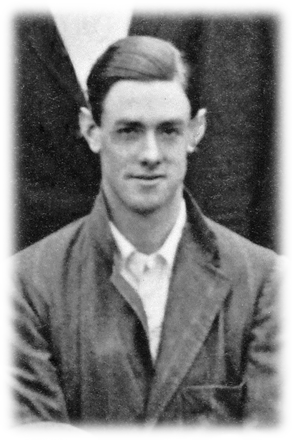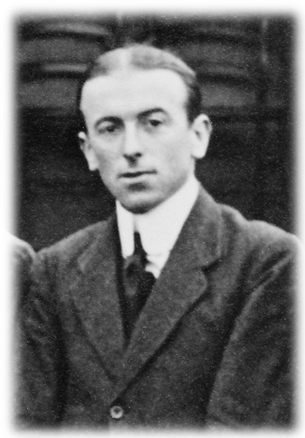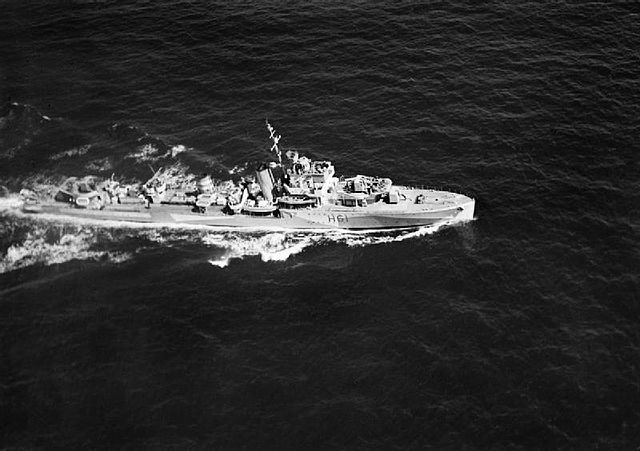World War One
In the two World Wars, Sussex CCC lost twelve players and one official. There is a memorial to those brave men outside the entrance to the museum (see right), and inside the museum, Gallery Two has information on all those who died.


Arthur Lang
Arthur Lang was born in Bombay on October 25, 1890, and educated at Harrow, where he was captain of the school side in 1908 and 1909, and played for the Public Schools against MCC at Lords. He played for Sussex thirteen times between 1911 and 1913, and also Cambridge for whom he was awarded a Blue. In his 22 First Class matches he scored 830 runs with top scores of 141 against Somerset and 104 against Cambridge University, both in 1903. He was also an excellent wicketkeeper. During WW1, Lang was a Lieutenant in the Grenadier Guards. He died in France at Cuinchy around January 26, 1915 following a German attack on British positions.

Kenneth Woodroffe
Kenneth Woodroffe was one of three brothers who fell in WW1. He was born in Lewes on December 9, 1892, and played for Sussex as a fast bowler twice in 1914. He had a first class batting average of 172 runs at 8.19 and 55 wickets at 27.2. Mr F.B. Wilson said of him in Wisden that ‘’He is really fast and can make the ball turn from the off on nearly any wicket. His action is a high and easy one, and being tall he often makes the ball get up very quickly.’’ In one of his two matches (against Surrey) he almost won the match by taking 6/43.
At the time of his death, Woodroffe was attached to the Welsh Regiment, having previously been in the 6th Battalion, Rifle Brigade. He died at Neuve Chappelle in May 1915 shortly after the abandonment of the Battle of Neuve Chappelle during which so many shells were expended that it led to a shell crisis. His brother Sidney was killed two months later and awarded the VC for bravery.

Geoffrey Dowling
Geoffrey Dowling, was born in Melbourne, Australia on August 12 1891, and educated at Charterhouse before playing for Sussex four times between 1911 and 1913, scoring 123 runs at 15.3. During the war he was a Captain in the Royal Rifle Corps when his unit was sent to Hooge, just east of Ypres. In early 1915, the Second Battle of Ypres raged around Hooge, a little village on a ridge located near a chateau which became a major target for both sides. On 30 July German forces attacked Hooge. The area had been quite quiet the night before until at 3.15am jets of fire began to explode around the stables near the Chateau, the first flame thrower attack of the war. The British lines were overrun and the men retreated to the support trenches. A second flame thrower attack was repulsed but the Germans managed to consolidate their captured positions. Dowling was killed the same day and the same place as 2nd Lieutenant Sidney C. Woodroffe, brother of Kenneth.

Bernard Holloway
Bernard Holloway was born in Wandsworth on January 13, 1888, was educated at The Leys, played lacrosse for England then played eight matches for Sussex between 1911 and 1914. Altogether he played 19 first class matches including a MCC tour to the West Indies in 1910-1911. He scored 701 runs at 22.6 including a century v British Guiana at Georgetown. Holloway also played rugby and lacrosse for Cambridge, and lacrosse for England.
During the war Holloway was a Captain in the Royal Sussex Regiment which took part in the biggest attack the British army made in 1915, at Loos on the Western Front, where the British used poison gas for the first time. The Royal Sussex Regiment 2nd Battalion was a part of the 2nd Brigade, 1st Division. The battalion had made a frontal attack which was repulsed by the Germans with heavy loss of life for the Sussex men, especially amongst the officers. Also on the Loos front that day John Kipling son of Rudyard was to lose his life in his first attack.

George Lumley Whatford
George Whatford was born in Eastbourne on July 20, 1878, was educated at Harrow and played for Sussex twice in 1904 scoring 21 runs at 10.5. During the war he was a Captain in the 66th Punjabis which was dispatched to Mesopotamia in 1915 and took part in the Battle of Shaiba where a Turkish counter attack was repulsed. In October it was part of the 6th Indian Division which advanced towards Baghdad and fought in the Battle of Ctesiphon which took place in November 1915 and where presumably Whatford died. He is commemorated on the Basra memorial and the Eastbourne War Memorial.

Charles Dennis Fisher
Charles Dennis Fisher was born in Blatchington, Sussex in 1877 the ninth of eleven children of Herbert Fisher and his wife Mary Louisa. He was educated in Westminster School after which he entered Christ Church College Oxford in 1896 gaining a BA in 1900 and an MA in 1903. He served as Senior Censor from 1910 to 1914, described as one of Oxford’s “most prominent members of its educational staff’’
He enjoyed walking and went on several tours of Italy during which he hoped to improve his understanding of Tacitus some of whose works he had edited.
Fisher played for Sussex between 1898 and 1903, and also represented Oxford in 1899 and 1900. For Sussex he scored 429 runs at 13,4, took seven catches and eight wickets at 30.2. He was a right handed batsman who bowled right arm medium pace and off breaks.


In his Wisden obituary, Fisher was described as 6 ft. 3in. in height and “a safe and steady batsman”. He was a consistent bowler who could maintain a good length in his deliveries. At Westminster, he was in the school’s first eleven for the four years 1893 to 1896 and captain in the last three. He obtained his Blue at Oxford in 1900 and played in the University match that year
At the beginning of the war Fisher learnt to drive and joined the Royal Army Medical Corps and served on the Western Front as an orderly and interpreter. He then retrained to join the Royal Navy in 1915, joining the Royal Naval Volunteer Reserve as a lieutenant. He was serving aboard HMS Invincible during the Battle of Jutland when a magazine explosion led to her sinking. HMS Invincible was built as a battlecruiser in 1907, the first of her type anywhere in the world. During WW1 Invincible fought in the Battle of Heligoland , albeit in a minor role as by then she was getting old but in the Battle of the Falklands, Invincible and her sister ship, Inflexible sank the cruisers Gneisenau and Scharnhorst. During the Battle of Jutland, Invincible was part of a scouting force for the Grand Fleet when a magazine explosion ripped the ship apart on 31 May 1916 and she was sunk with the loss of 1026 lives. Charles was 38 when he died and he is commemorated on the Portsmouth memorial on Southsea Common.
John William Washington Nason
John William Washington Nason was killed in action at Vlamertinge in West Flanders on Boxing Day 1916 while flying with the Royal Flying Corps; he was 27. Playing as an amateur, he appeared in 22 first-class matches for Sussex during school and university holidays between 1906 and 1910, as a right-hand middle-order batsman and occasional right-arm slow bowler, scoring 539 runs at 18.58, taking one wicket and making 13 catches.
He was born at Corse in Gloucestershire in 1889, the second son of a doctor. The family later moved to St Leonards, where he attended a private school, University School, in Hastings, establishing a local reputation as a fast-scoring batsman. His first match for the Sussex first eleven, in 1906, was unusual. He was a spectator, not long past his seventeenth birthday, at the old Central Ground on the first day of the match with Warwickshire, when he was asked to field as substitute for Ben Dwyer, the Sussex opening bowler, who had injured a hand while fielding. Nason was later allowed to bat by Warwickshire in breach of the Laws as they the stood, top-scoring with 53 in the second innings when Sussex followed on. He remained the youngest player to score a fifty in the County Championship until 2001.
He went to Queens’ College, Cambridge in October 1908, and duly played for the University side in fifteen matches in 1909 and 1910, scoring 476 runs in the middle order at 19.04 and taking five wickets. He played occasional matches for the University football side without collecting a blue. He seems not to have completed his degree course and by 1911 had become a schoolteacher.

Nason played nineteen matches for Gloucestershire in the summers of 1913 and 1914, obtaining his highest first-class score in his first season there with 139 in 195 minutes against Nottinghamshire at Gloucester. In August 1914 he secured an Army commission and was promoted to captain in November of that year; he married Dorothea Gawthorne, the daughter of a lawyer, in Hastings in the summer of 1915. He transferred to the Royal Flying Corps in January 1916 where he was regarded as ‘an extremely useful pilot’. His Times obituary noted his prowess as a golfer at the Cooden Beach club. His estate of £3,282 was granted probate in June 1917; they had no children. His widow remarried in 1919 in Richmond, Surrey.
Francis Arthur Joseph Oddie
Francis Arthur Joseph Oddie, often known as Frank, was killed in action on 23 October 1916, at the age of 37, near Thiepval, Somme, France towards the end of a long battle lasting several weeks to capture high ground near the village. He had been secretary of the Sussex County Cricket Club since 1913. Unlike others among the club’s administrators he had not played for the county’s first eleven, but had played in club cricket.
Born at Horsham in the fourth quarter of 1878, he was the older of two sons of Arthur Campbell Oddie, a property owner, who was a leading figure in Horsham cricket and the principal figure, said to be of ‘Messianic’ disposition, in the establishment of the Horsham Cricket Festival which started in 1908.
After leaving Beaumont College near Windsor, Frank went to work in Sheffield in the steel industry, later becoming a sub-editor and then a journalist with the Sheffield Daily Telegraph. He married Lilian Etheridge in Sheffield in the summer of 1901. In 1913 he was appointed as the county club secretary in succession to Col E.A.Bruce, a former Gloucestershire cricketer who had retired at the age of 64, and moved to Bigwood Avenue close to this ground. He had been Bruce’s assistant for a couple of years before this.
He enlisted very early in the Great War and was commissioned as a lieutenant in the Warwickshire Regiment in February 1915. He was sent to France in July 1916 and shortly afterwards was transferred to the Middlesex Regiment. At the time of his death he was attached to the Berkshire Regiment. His wife died at Horsham in 1931, aged 55. Frank is on the Thiepval memorial.

Ernest Relf
Ernest Relf was born in Sandhurst in 1888, the brother of Albert and Robert. He played twelve times for Sussex between 1912 and 1914 making 232 runs at an average of 11.6 and took eight wickets at 26.5. During the war he was a gunner in the 337th Siege Battery, Royal Artillery. He died in Evington, Leicester on July 27, 1918. There was a large military hospital in Evington and I can only presume that he was wounded during active service and was brought to Evington, where he did not recover. He was buried in Reading Cemetery.

World War Two
Kenneth Scott
Kenneth Scott was born in Uckfield in August 1915 and played fourteen matches for Sussex between 1935 and 1937. He scored 274 runs with a highest score of 56 and he also took 12 wickets. He was serving in the Royal Queen’s Own Royal West Kent, most likely in the 6th battalion of the Regiment, during the invasion of Sicily when he died aged 27 near Syracuse in Sicily on 9 August 1943. He is buried in the war cemetery at Catania.

Alexander Shaw
Alexander Shaw was born in September 1907 in Shardlow, Derbyshire. Shaw was a batsman and wicketkeeper who in his debut for Sussex against Cambridge University caught three batsmen and stumped three others. His only other first class match was for Bengal when he scored a single run in the two innings he had.
Shaw was serving as a Captain in the 11th Sikh Regiment, most likely in the Burma Campaign, when he died on 19 July 1945. He is buried in Delhi War Cemetery.

Robert Alexander Tamplin Miller
Robert Alexander Miller was born in Travancore in November 1895. He played in twelve matches for Sussex scoring 191 runs, taking nine catches and made 11 stumpings. He died on 10 July 1941, aged 45 and was buried in Maala, South Yemen. At the time of his death he was 45 years old and a major.
Robert Boughey
John Boughey was born on 22 March 1919 in Godstone, Surrey. His parents were Lord George Boughey and Lady Boughey of Glynde. He attended Eton College and Magdalen College, Cambridge before being commissioned in the Coldsteam guards. In May 1940 he played for a Sussex XI against the RAF at Lewes.

On the night of 31 August 1940, Boughey was serving aboard HMS Express (in No 2 Company 2nd Battalion) in the British 20th Destroyer Flotilla sailing from Immingham to the Dutch coast. He might have been providing an escort for the transfer of prisoners. While the ships were laying mines, air reconnaissance detected a German naval presence in the area, and the flotilla of destroyers was ordered to intercept. Whilst doing so it ran into an unknown mine field and three destroyers, including Express were damaged. Ninety of the 175 men aboard were either killed or wounded, including Boughey who was subsequently buried at sea. Boughey was 21 years old and is commemorated in South Malling Churchyard.
During his short service life Boughey wrote poetry, some of which is included in the Oxford University Press anthology of poetry written by young men from English public schools. Anticipating his own death Boughey wrote Last Night I Dreamed
Last night I dreamed that to my bed there came
A heavenly vision, calling me by name
Who, standing in the moonlight, softly said
‘Arise and follow me, for you are dead.’
Then in a sudden, timeless flash unfurled
Before my eyes, the compass of the world;
Before me lay eternity revealed
And all the secrets in earth’s bosom sealed.
Thus, for a space I stood and watched, supreme
Wrapt in the matchless splendour of my dream,
And, suddenly I knew that time and death
Were but the fable on man’s lying breath